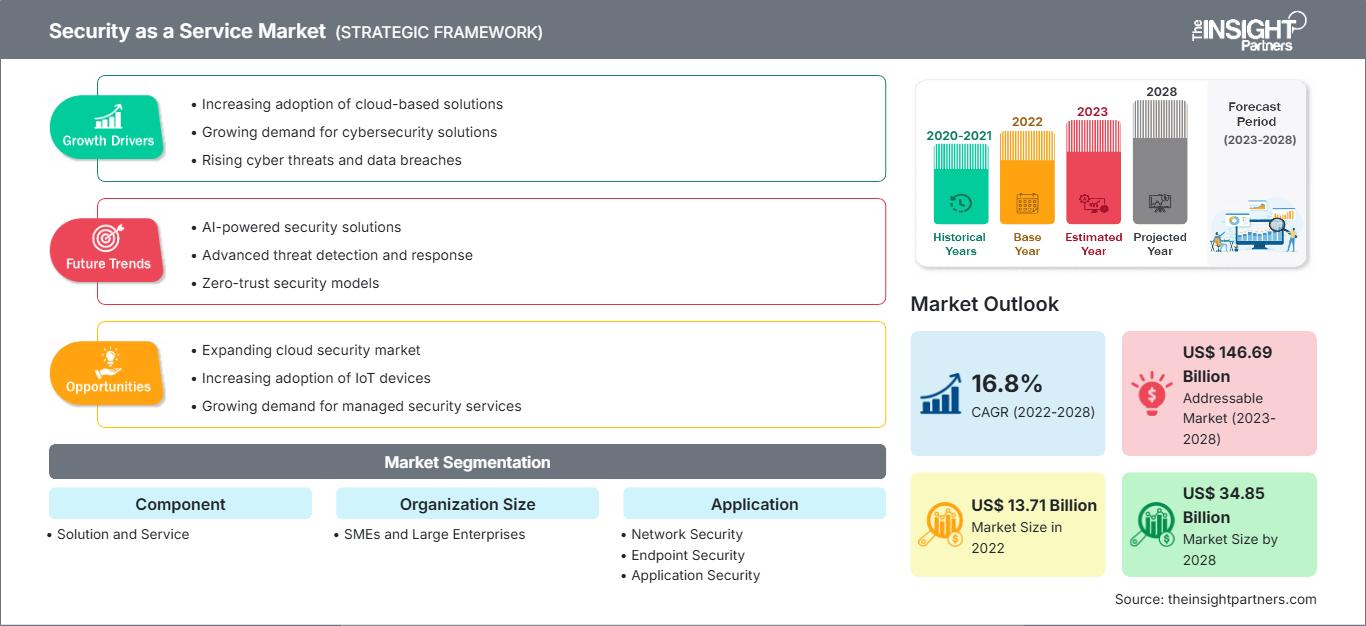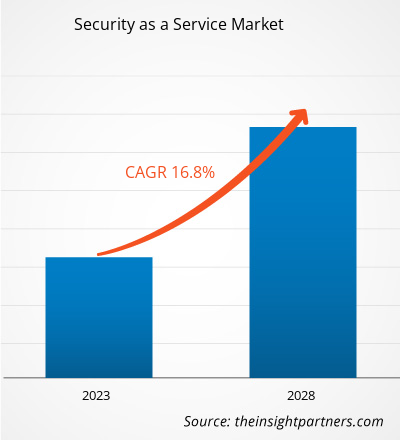Der Markt für Security as a Service soll von 13.712,87 Millionen US-Dollar im Jahr 2022 auf 34.854,10 Millionen US-Dollar im Jahr 2028 anwachsen. Von 2022 bis 2028 wird ein CAGR-Wachstum von 16,8 % erwartet.
Security as a Service ist eine Technik, um Unternehmen Sicherheitslösungen für Rechenzentren oder regionale Gateways bereitzustellen. Da es den sicheren Zugriff auf Apps ermöglicht, ist es für Unternehmen zu einem entscheidenden Ansatz geworden, ihre mobilen und Cloud-Bereitstellungen zu steigern. Um die Anwendungssicherheit von Unternehmen zu erhöhen, werden verschiedene Sicherheitslösungen eingesetzt. Data Loss Prevention (DLP), Compliance-Lösungen, erweiterter Malware-Schutz, Entscheidungen von Cloud Access Security Brokern und kontinuierliche Überwachung sind nur einige der angebotenen Sicherheitslösungen. Die Dienstanbieter berechnen Unternehmen eine angemessene monatliche Gebühr für ihre Dienste. Aufgrund dieser Vorteile treten Endverbraucherbranchen zunehmend an Marktteilnehmer heran, was die globale Expansion des Marktes für Security as a Service voraussichtlich vorantreiben wird. Unternehmen nutzen Security as a Service in großem Umfang, da es gegenüber herkömmlichen Ansätzen zahlreiche Vorteile bietet, darunter schnellere Abläufe, laufende Virenupdates, kostengünstige Lösungen und einen schnelleren Betrieb.
Die weltweite Nachfrage nach Sicherheitslösungen wächst auch aufgrund der zunehmenden Digitalisierung und der Nutzung cloudbasierter Dienste in verschiedenen Branchen. Viele Unternehmen haben in letzter Zeit Business-Apps, Bring-Your-Own-Device-Richtlinien (BYOD), Choose-Your-Own-Device-Trends (CYOD) und andere Technologien eingeführt. Die Sorge um die Integrität und Vertraulichkeit von Unternehmensdaten ist aufgrund dieser Trends gewachsen. Weltweit nutzen über 3,7 Milliarden Menschen E-Mail, und aufgrund der Entwicklung elektronischer Marketingmethoden werden täglich 269 Milliarden E-Mails versendet. Dies bietet Hackern enorme Möglichkeiten, Spam-E-Mails an Benutzer zu senden, um an wichtige Informationen über sie zu gelangen. Die meisten Sicherheitsprobleme beginnen mit Phishing-E-Mails, mit denen Hacker Opfer dazu verleiten, ihnen Zugriff auf Konten, Logins oder Finanzinformationen zu gewähren, bevor sie zu technischen Hacks übergehen. Daher fördert die zunehmende Bedeutung der Cybersicherheit das Wachstum des Marktes für Sicherheit als Dienstleistung stark.
Passen Sie diesen Bericht Ihren Anforderungen an
Sie erhalten kostenlos Anpassungen an jedem Bericht, einschließlich Teilen dieses Berichts oder einer Analyse auf Länderebene, eines Excel-Datenpakets sowie tolle Angebote und Rabatte für Start-ups und Universitäten.
Security-as-a-Service-Markt: Strategische Einblicke

- Holen Sie sich die wichtigsten Markttrends aus diesem Bericht.Dieses KOSTENLOSE Beispiel umfasst Datenanalysen, die von Markttrends bis hin zu Schätzungen und Prognosen reichen.
Sie erhalten kostenlos Anpassungen an jedem Bericht, einschließlich Teilen dieses Berichts oder einer Analyse auf Länderebene, eines Excel-Datenpakets sowie tolle Angebote und Rabatte für Start-ups und Universitäten.
Security-as-a-Service-Markt: Strategische Einblicke

- Holen Sie sich die wichtigsten Markttrends aus diesem Bericht.Dieses KOSTENLOSE Beispiel umfasst Datenanalysen, die von Markttrends bis hin zu Schätzungen und Prognosen reichen.
Auswirkungen der COVID-19-Pandemie auf das Wachstum des Security-as-a-Service-Marktes
Der kontinuierliche Anstieg der Zahl der mit dem neuen Coronavirus infizierten Patienten zwang die Regierungsbehörden in den ersten drei Quartalen 2020 dazu, in den USA und anderen Regionen strenge Ausgangssperren zu verhängen. Der Fertigungssektor erlitt aufgrund vorübergehender Fabrikschließungen schwere Verluste, während die meisten Unternehmen gezwungen waren, auf Telearbeit umzustellen. Die zunehmende Verbreitung von Homeoffice führte zu einem Anstieg der Cyberangriffe und dem Bedarf an Schutz davor. Kleine und mittlere Unternehmen waren gezwungen, mehr in Netzwerksicherheitslösungen zu investieren. Trotz dieser Auswirkungen wurde die Größe des Security-as-a-Service-Marktes durch die Pandemie positiv beeinflusst. In den USA wurde ein starker Anstieg von Phishing und der Verbreitung von Malware mit Ködern im Zusammenhang mit COVID-19 sowie die Registrierung neuer Domänennamen mit Begriffen im Zusammenhang mit dem Coronavirus oder COVID-19 beobachtet.
In der Region kam es auch zu einem Anstieg der Online-Transaktionen, was Cyberkriminelle zusätzlich anzog. Daher begannen Unternehmen, sich auf ihre Cybersicherheitsinfrastruktur zu konzentrieren, um Kunden und Mitarbeiter zu schützen. Dies schuf große Wachstumschancen für Marktteilnehmer. Microsoft berichtete, dass zwischen Februar und Mai 2020 im asiatisch-pazifischen Raum 19 Millionen Phishing- und Ransomware-Angriffe mit einem COVID-19-Thema festgestellt wurden. Da viele Menschen während der Pandemie gezwungen waren, in hastig geschaffenen, weniger sicheren Umgebungen zu arbeiten, wurde die zunehmende Nutzung cloudbasierter Dienste zu einem Hotspot für Cyberangriffe. COVID-19 beeinflusste daher das Wachstum des globalen Marktes für Sicherheit als Dienstleistung positiv.
Markteinblicke – Markt für Security as a Service
Der Aufstieg des E-Business, das wachsende Bewusstsein für Datenschutz, der Trend zu Bring-Your-Own-Devices (BYOD) und die Akzeptanz verwalteter Sicherheitsmaßnahmen eröffnen bedeutende Marktaussichten. Die Nutzung von Cloud-Technologien hat im Laufe der Zeit deutlich zugenommen, was die Nachfrage nach zuverlässigeren und kostengünstigeren Sicherheitslösungen erhöht hat. Die IT-Infrastruktur ist in den letzten fünf Jahren aufgrund der Einführung neuer Plattformen, BYOD-Vorschriften, CYOD-Trends, Business-Apps und anderer Technologien komplexer und heterogener geworden. BYOD und CYOD-Trends werden aufgrund der schnellen Fortschritte im mobilen Computing in Geschäftsumgebungen immer häufiger. Aufgrund der Einführung des BYOD-Modells schließen Unternehmen Sicherheitsdienste ab, um Geräte wie Smartphones, Tablets, Desktop-Computer und Laptops vor Cybergefahren zu schützen. Solche Trends treiben den Markt für Security as a Service zwangsläufig voran.
Einblicke nach Unternehmensgröße
Der Markt für Security as a Service ist nach Unternehmensgröße in Großunternehmen und KMU (kleine und mittlere Unternehmen) unterteilt. Für das KMU-Segment wird im Prognosezeitraum eine höhere durchschnittliche jährliche Wachstumsrate (CAGR) erwartet. Laut Weltbank tragen KMU in Schwellenländern etwa 40 % zum BIP und 60 % zur Gesamtbeschäftigung bei. Da immer mehr KMU ihre Abläufe vereinfachen und die Betriebskosten senken, erleben die Akteure des Marktes für Security as a Service eine erhebliche Nachfrage nach Sicherheitslösungen aus diesem Segment. Da die Digitalisierung dem KMU-Segment neue Möglichkeiten eröffnet, wird für dieses Segment im Markt für Security as a Service eine höhere Wachstumsrate prognostiziert.
Der Markt für Security as a Service wird nach Komponente, Unternehmensgröße, Anwendung und Branche analysiert. Basierend auf der Komponente wird der Markt in Lösungen und Dienstleistungen unterteilt. Nach Unternehmensgröße wird der Markt in KMU und Großunternehmen segmentiert. Nach Anwendung ist der Markt in Netzwerksicherheit, Endpunktsicherheit, Anwendungssicherheit, Cloud-Sicherheit und andere segmentiert. Basierend auf den Branchen ist der Markt in BFSI, Regierung & Verteidigung, Einzelhandel, Gesundheitswesen, IT & Telekommunikation, Energie & Versorgung, Fertigung und andere segmentiert. Geografisch ist der Markt für Sicherheit als Dienstleistung hauptsächlich in Nordamerika, Europa, Asien-Pazifik (APAC), den Nahen Osten und Afrika (MEA) sowie Südamerika (SAM) segmentiert.
Sicherheit als DienstleistungsmarktSicherheit als Dienstleistungsmarkt
Die Analysten von The Insight Partners haben die regionalen Trends und Faktoren, die den Security-as-a-Service-Markt im Prognosezeitraum beeinflussen, ausführlich erläutert. In diesem Abschnitt werden auch die Marktsegmente und die geografische Lage von Security-as-a-Service in Nordamerika, Europa, Asien-Pazifik, dem Nahen Osten und Afrika sowie Süd- und Mittelamerika erörtert.Umfang des Marktberichts „Security as a Service“
| Berichtsattribut | Einzelheiten |
|---|---|
| Marktgröße in 2022 | US$ 13.71 Billion |
| Marktgröße nach 2028 | US$ 34.85 Billion |
| Globale CAGR (2022 - 2028) | 16.8% |
| Historische Daten | 2020-2021 |
| Prognosezeitraum | 2023-2028 |
| Abgedeckte Segmente |
By Komponente
|
| Abgedeckte Regionen und Länder | Nordamerika
|
| Marktführer und wichtige Unternehmensprofile |
|
Dichte der Akteure auf dem Security-as-a-Service-Markt: Die Auswirkungen auf die Geschäftsdynamik verstehen
Der Markt für Security-as-a-Service wächst rasant. Die steigende Nachfrage der Endnutzer ist auf Faktoren wie veränderte Verbraucherpräferenzen, technologische Fortschritte und ein stärkeres Bewusstsein für die Produktvorteile zurückzuführen. Mit der steigenden Nachfrage erweitern Unternehmen ihr Angebot, entwickeln Innovationen, um den Bedürfnissen der Verbraucher gerecht zu werden, und nutzen neue Trends, was das Marktwachstum weiter ankurbelt.

- Holen Sie sich die Security-as-a-Service-Markt Übersicht der wichtigsten Akteure
Alert Logic, Inc., Barracuda Networks, Inc., IBM Corporation, McAfee LLC, Microsoft Corporation, Radware, Trend Micro Incorporated, Clearswift, Silversky und Zscaler, Inc. sind die wichtigsten Akteure auf dem Security-as-a-Service-Markt.
Die Marktteilnehmer konzentrieren sich stark auf Fusionen und Übernahmen. Hier ist eine Momentaufnahme der jüngsten Entwicklungen auf dem Security-as-a-Service-Markt:
- HelpSystems kündigte 2022 Pläne zur Übernahme von Alert Logic an, um Kunden einen hybriden IT-Ansatz zur Behebung des Fachkräftemangels im Bereich Cybersicherheit zu bieten.
- IBM Corporation kündigte 2022 Pläne zur Übernahme von Randori an, einem Anbieter von offensivem Cyberschutz und Angriffsflächenmanagement. Laut ITPro beabsichtigt IBM, die Software von Randori mit den erweiterten Erkennungs- und Reaktionsfunktionen (XDR) von IBM Security QRadar zu kombinieren.
- Historische Analyse (2 Jahre), Basisjahr, Prognose (7 Jahre) mit CAGR
- PEST- und SWOT-Analyse
- Marktgröße Wert/Volumen – Global, Regional, Land
- Branchen- und Wettbewerbslandschaft
- Excel-Datensatz
Aktuelle Berichte
Verwandte Berichte
Erfahrungsberichte
Grund zum Kauf
- Fundierte Entscheidungsfindung
- Marktdynamik verstehen
- Wettbewerbsanalyse
- Kundeneinblicke
- Marktprognosen
- Risikominimierung
- Strategische Planung
- Investitionsbegründung
- Identifizierung neuer Märkte
- Verbesserung von Marketingstrategien
- Steigerung der Betriebseffizienz
- Anpassung an regulatorische Trends






















 Kostenlose Probe anfordern für - Security-as-a-Service-Markt
Kostenlose Probe anfordern für - Security-as-a-Service-Markt